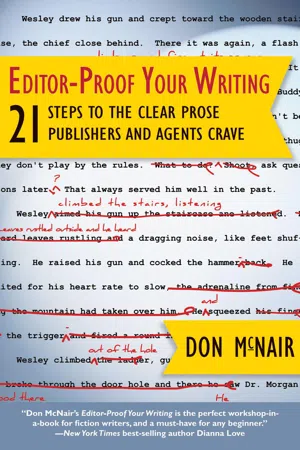![]()
Contents
Introduction: You can be published!
PART ONE: PUTTING WORDS IN
| CHAPTER 1 | Your classroom? It’s your first chapter! |
| CHAPTER 2 | Why you should be a hooker |
| CHAPTER 3 | What’s your point of view? |
| CHAPTER 4 | Don’t be an information dumper |
| CHAPTER 5 | Your manuscript is a Christmas tree |
| CHAPTER 6 | William Brennan: A “Christmas tree” case history |
| CHAPTER 7 | Make your scenes work harder |
| CHAPTER 8 | Don’t discuss sows’ ears with silken words |
| CHAPTER 9 | You say your heroine doesn’t hate your hero? Too bad! |
| CHAPTER 10 | But they have to like each other, too! |
PART TWO: TAKING WORDS OUT
Introduction: 21 Steps to fog-free writing
| STEP 1 | Use fewer –ing words |
| STEP 2 | Use fewer infinitives |
| STEP 3 | Change passive voice to active voice |
| STEP 4 | Avoid “expletive” and “had ____ that” constructions |
| STEP 5 | Use fewer “hads” in internal dialogue |
| STEP 7 | Eliminate double verbs |
| STEP 8 | Eliminate double nouns, adjectives, and adverbs |
| STEP 9 | Watch for foggy phrases |
| STEP 10 | Remove character filters |
| STEP 12 | Get rid of all dialogue tags except “said” |
| STEP 13 | Now, get rid of “said”! |
| STEP 14 | Cut the dialogue! |
| STEP 15 | Eliminate redundancies |
| STEP 16 | Use fewer prepositional phrases |
| STEP 17 | Get rid of throwaway words |
| STEP 18 | Edit for conciseness |
| STEP 19 | Avoid clichés like the plague |
| STEP 20 | Get rid of superficials |
| STEP 21 | Stop those wandering eyes |
PART THREE: SHARING YOUR WORDS
Introduction: Sharing Your Work
| CHAPTER 11 | Critique partners |
| CHAPTER 12 | Professional editors |
| CHAPTER 13 | Publishers and agents |
| CHAPTER 14 | Writing the query letter |
| CHAPTER 15 | Writing the synopsis |
Appendix
Exercise Solutions
Sarah’s Perils Solutions
Mystery on Firefly Knob Synopsis
Novels used as examples
Index
About the author
![]()
INTRODUCTION
You can be published!
Unpublished writer “Barbara Stevens” asked me to critique and edit her newest unpublished novel’s first chapter. “I’ve written twelve other manuscripts,” she said, “and they’ve been rejected a lot of times. I hope you can figure out what’s wrong.”
Well, I did figure it out, and quickly. This lady was basically a good writer. Her blogs sparkled, she dreamed up creative plots, and her heart was certainly in her work. But she’d made a major craft mistake in that chapter and, presumably, in all twelve of those manuscripts. It was a mistake that almost guaranteed she’d never be published.
We discussed her problem (we’ll get back to that later), and the light bulb over her head glowed brilliantly. She rewrote that first chapter and I edited it again, and, as if by magic, it became publishable. Barbara used her newfound knowledge to revise the rest of that manuscript, and then her twelve other novels. Within two months she sold one, and she’s now been published many times. She’s on her way.
The point? Barbara’s breakthrough came directly from correcting that one craft mistake. She’d made it time and time again and was destined to repeat it again and again, until someone told her what it was.
You may be making that same mistake. Or, perhaps you’re making another equally deadly one—mistakes we’ll identify and resolve in this book—and are not aware of it. But there’s hope.
Bad news, good news
If you’ve never been published, there’s both bad news and good news.
The bad news is that most unpublished writers will never be published. Editors receive hundreds of manuscripts each week and ultimately buy fewer than one percent. We’ve all heard of hapless writers who have wallpapered their home or office walls with rejections. Perhaps you’re one.
The reason is basic. Many writers send problem-riddled manuscripts to editor after editor, as Barbara did, believing they are perfect. In the meantime they blithely build the same flaws into their next manuscript. They simply don’t know they’re making those mistakes. Unless someone tells them or they somehow learn on their own, their manuscripts will be rejected the rest of their lives.
Note, however, that someone does recognize their problems. Those editors! They quickly spot them in a manuscript’s first chapter—often on the first page—and reject the submission without reading further. They know the rest of the manuscript contains the same mistakes, just as we know an iceberg’s submerged part is made up of more of the same ice seen on top. Editors simply don’t have the time or inclination to teach authors writing skills. So they send out “sorry, it’s not for us” letters and move on to the next manuscript in their bulging in-baskets.
The good news? That can change!
It’s time for someone to tell these writers what they’re doing wrong. And that, of course, is the purpose of this book. If you apply what you learn here to your current and future manuscripts, they’ll be tremendously improved. Improved enough, perhaps, to entice that next editor to take you on.
I’ve seen your problems many times. I edited trade magazines for twelve years, supervised writers while writing for a major PR firm’s national clients for six years, and headed my own company (McNair Marketing Communications) for twenty-two years. For the last five years I’ve run my own editing firm (McNairEdits.com), where I polish other writers’ work. Believe me, I know firsthand the problems many writers build into their ma...
